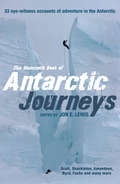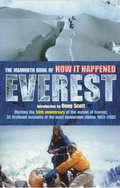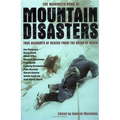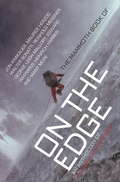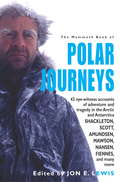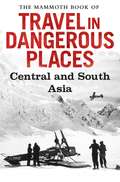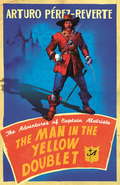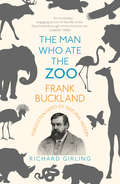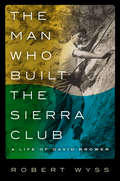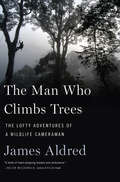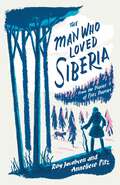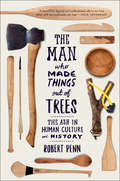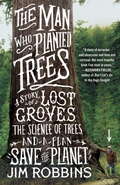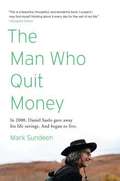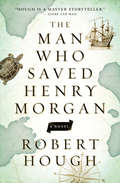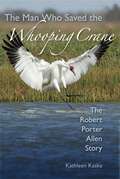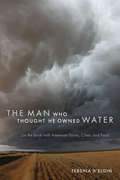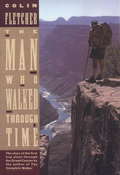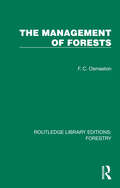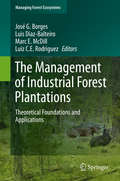- Table View
- List View
The Mammoth Book of Antarctic Journeys: 32 eye-witness accounts of adventure in the Antarctic
by Jon E. LewisThe very best writing on the Antarctic, from James Cook's eighteenth-century assertion that 'no man will ever venture further than I have done' to Lynne Cox's description of her epic, icy swim in the twenty-first century - 32 first-hand accounts of men and women challenging one of the Earth's last true wildernesses. Here you will find both legendary tales of heroism and startling contemporary accounts of the impact of global warming on the Earth's sole undeveloped continent, including: 'Dog Days' by Robert Falcon Scott. 'The Loss of the Endurance' by Ernest Shackleton. 'Alone' by Richard E Byrd .'The Killer under the Water' by Gareth Wood. 'Melting Point' by David Helvarg. 'Swimming to Antarctica' by Lynne Cox.
The Mammoth Book of How it Happened - Everest (Mammoth Books #376)
by Jon E. LewisBegining with the 1921 attempt on the summit of Everest through to the disasters of the 1990s, this work features 30 white-knuckle accounts of climbing endeavour on the world's highest mountain, with all the tragedy and triumph of humankind's striving for the top of the world, by those who know the "Death Zone" best - the climbers of Everest themselves. Yet this is more than a cherry-picking of great true and exhilarating memoirs of Everest. Included are the history of the conquest of Everest, and all the natural and cruel beauty of Chomolungma "The Mother Goddess of the World".
The Mammoth Book of Mountain Disasters (Mammoth Books #398)
by Mr Hamish MacInnesCaught way up on the mountain, no one is safe, from the archetypal nightmare of Tony Kurtz, seen to freeze to death by his stranded rescuers as he hung off the Eiger, to events that unfolded on the Grand Teton, where rescuers narrowly escaped being clubbed to death by their reluctant rescuees. This collection of 35 first-hand accounts will shock and inspire in equal measure. Here is the original draft of Joe Simpson's classic Touching the Void and the first full telling of Jamie Andrew's extraordinary rescue from the Alps, which made headlines in 1999. Plus a specially commissioned account of the epic winter rescue on Mount Ararat, 2000 - the most remote mission ever undertaken by a helicopter-rescue team. And the rescuers own grim battles for survival.Compiled by one of the world's most respected mountaineers, this volume spans five continents - from the Appalachians to Mount Cook, from Peak Lenin to Siula Grande. It includes some of the brightest stars of mountaineering and mountain rescue: Joe Simpson, Doug Scott, Pete Sinclair, Milos Vrbe, Paul Nunn, Ludwig Gramminger, Karen Glazley, Ken Phillips and Blaise Agresti.
The Mammoth Book of Mountain Disasters (Mammoth Books)
by Hamish MacInnesCaught way up on the mountain, no one is safe, from the archetypal nightmare of Tony Kurtz, seen to freeze to death by his stranded rescuers as he hung off the Eiger, to events that unfolded on the Grand Teton, where rescuers narrowly escaped being clubbed to death by their reluctant rescuees. This collection of 35 first-hand accounts will shock and inspire in equal measure. Here is the original draft of Joe Simpson's classic Touching the Void and the first full telling of Jamie Andrew's extraordinary rescue from the Alps, which made headlines in 1999. Plus a specially commissioned account of the epic winter rescue on Mount Ararat, 2000 - the most remote mission ever undertaken by a helicopter-rescue team. And the rescuers own grim battles for survival.Compiled by one of the world's most respected mountaineers, this volume spans five continents - from the Appalachians to Mount Cook, from Peak Lenin to Siula Grande. It includes some of the brightest stars of mountaineering and mountain rescue: Joe Simpson, Doug Scott, Pete Sinclair, Milos Vrbe, Paul Nunn, Ludwig Gramminger, Karen Glazley, Ken Phillips and Blaise Agresti.
The Mammoth Book of On The Edge
by Jon E. LewisNo one sees clearer than an individual whose life is hanging by the finger tips on the edge of an abyss. Probing the furthest reaches of human daring and endurance, here are 28 of the great first-hand accounts of extreme mountaineering, from legendary names. Featuring:·Heinrich Harrer - first conqueror of the notorious Eigerwand.·Robert Bates - the classic account of the ill-fated American 1953 expedition to K2.·Maurice Herzog - his unstoppable ascent of Annapurna at the cost of frostbite.·Walter Bonatti - tragedy on the Central Pillar of Freney on Mont Blanc.·George Leigh Mallory - surviving an avalanche on the 1922 Everest expedition.·René Desmaison - his epic story of 14 days stuck on The Grandes Jorasses in winter.·Jon Krakauer - recalling his solo ascent of The Devil's Thumb in Alaska.The price of the summit is often measured in human suffering, yet for those who succeed the rewards can be incalculable. Nerve-wracking and unputdownable.
The Mammoth Book of On The Edge (Mammoth Books #383)
by Jon E. LewisNo one sees clearer than an individual whose life is hanging by the finger tips on the edge of an abyss. Probing the furthest reaches of human daring and endurance, here are 28 of the great first-hand accounts of extreme mountaineering, from legendary names. Written by the bestselling author of Meadowland and The Running Hare, Featuring:·Heinrich Harrer - first conqueror of the notorious Eigerwand.·Robert Bates - the classic account of the ill-fated American 1953 expedition to K2.·Maurice Herzog - his unstoppable ascent of Annapurna at the cost of frostbite.·Walter Bonatti - tragedy on the Central Pillar of Freney on Mont Blanc.·George Leigh Mallory - surviving an avalanche on the 1922 Everest expedition.·René Desmaison - his epic story of 14 days stuck on The Grandes Jorasses in winter.·Jon Krakauer - recalling his solo ascent of The Devil's Thumb in Alaska.The price of the summit is often measured in human suffering, yet for those who succeed the rewards can be incalculable. Nerve-wracking and unputdownable.
The Mammoth Book of Polar Journeys (Mammoth Books)
by Jon E. LewisExerting a magnetic pull our imaginations, the poles have been the object of many gripping first-hand accounts of exploration - literally, journeys to the ends of the earthA passport to the last wildnernesses of Earth, this is the definitive collection of first-hand accounts of polar exploration - 50 true stories of intrepid travel through the desolate and dangerous regions of both Arctic and Antarctic. Beginning with Sir John Franklin's starvation trek through Alaska in 1821 and ending with Vassilli Gorshkovsky's northern expedition aboard a creaking ice-breaker in 2005, these true stories encompass every kind of triumph and disaster.The inspired but doomed courage of Captain Scott, and the marvellous leadership of Shackleton are well known, but here are many other stories including: The Bear, by Frederick A. Cook, 1908 Meeting with Polar Eskimos by Knud Rasmussen, 1932 By Dog-Sledge to the Top of the World, by Wally Herbert, 1968 Hell on Earth by Reinhold Messner, 1989-90 Solo by Pen Haddow, 2003 And many more.
The Mammoth Book of Travel in Dangerous Places: Central and South Asia (Mammoth Books #349)
by John KeayAlarms amongst the Uzbeks - Alexander BurnesOf all the "forbidden" cities (Timbuktu, Mecca, Lhasa, Riyadh and so on) none enjoyed a more fearsome reputation that Bukhara in Uzbekistan. The first British Indian expedition, that of William Moorcroft in 1819-26, had never returned. Moorcroft's disappearance, like that of Livingstone or Franklin, posed a challenge in itself and preyed on the minds of his immediate successors. Heavily disguised and in an atmosphere of intense intrigue, Burnes and Dr James Gerard crossed the Afghan Hindu Kush in 1832 and approached the scenes of Moorcroft's discomfiture. They would both return; and "Bukhara Burnes" would become the most renowned explorer of his day.On the Roof of the World - John WoodIn 1937 Alexander Burnes returned to Afghanistan on an official mission. Amongst his subordinates was a ship's lieutenant who, having surveyed the navigational potential of the river Indus, took off on a mid-winter excursion into the unknown Pamirs between China and Turkestan. Improbably, therefore, it was John Wood, a naval officer and the most unassuming of explorers, who became the first to climb into the hospitable mountain heartland of Central Asia and the first to follow to its source the great river Oxus (or Amu Darya.)Exploring Angkhor - Henri MouhotBorn in France, Mouhot spent most of his career in Russia as a teacher and then in the Channel Islands. A philologist by training, he also took up natual history and it was with the support of the Royal Zoological Society that in 1858 he set out for South East Asia. From Siam (Thailand) he penetrated Cambodia and Laos, where he died; but not before reaching unknown Angkhor and becoming the first to record and depict the most extensive and magnificent temple complex in the world. His discovery provided the inspiration for a succession of subsequent French expeditions up the Mekong.Over the Karakorams - Francis Edward YounghusbandAs leader of the 1904-5 British military expedition to Lhasa and as promoter of the early assaults on Mount Everest, Younghusband came to epitomize Himalayan endeavour. To the mountain he also owed his spiritual conversion from gung-ho solider to founder of the World Congress of Faiths. His initiation came in 1887 when, as the climax to journey from Peking across the Gobi desert, he determines to reach India over the unexplored Mustagh Pass in the Karakorams - "the most difficult and dangerous achievement in these mountains so far" (S.Hedin).Trials in Tibet - Ekai KawaguchiBy the 1890's the capital of "forbidden" Tibet, unseen by a foreigner since Huc's visit, represented the greatest challenge to exploration. Outright adventurers like the dreadful Henry Savage Landor competed with dedicated explorers like Sven Hedin, all succumbed to to a combination of official vigilance and physical hardship. The exception, and the winner in "the race for Lhasa", was a Buddhist monk from Japan whose expedition consisted of himself and two sheep. Ekai Kawaguchi was supposedly a pilgrim seeking religious texts. His faith was genuine and often tested, as during this 1900 excursion into western Tibet; but he is also thought to have been an agent of the British government in India.
The Man In The Yellow Doublet: The Adventures Of Captain Alatriste (The Adventures of Captain Alatriste)
by Arturo Perez-ReverteCaptain Alatriste returns in a swashbuckling tale of intrigue, romance and regicide.Captain Alatriste's affair with the beautiful actress Maria de Castro is rankling not only his long-term mistress but also the King of Spain. With loyal companion Inigo distracted by the affections of Angelica, Alatriste becomes embroiled in a series of tussles outside his lover's house. Ambushed by arch-nemesis Malatesta, a skirmish ensues that leads to the death of Maria's other lover - the monarch himself. But behind this tale of sexual jealousy lurks a darker truth. As it becomes clear that both Alatriste and Inigo have been cunningly honey trapped - and that the dead man was an impostor. With a puppet king waiting dutifully in the wings, Alatriste must use all his cunning and swordsmanly guile to prevent the murder of the real king - and his implication in a crime for which he has been perfectly framed.
The Man Who Ate the Zoo: Frank Buckland, forgotten hero of natural history
by Richard GirlingFrank Buckland was an extraordinary man – surgeon, natural historian, popular lecturer, bestselling writer, museum curator, and a conservationist before the concept even existed. Eccentric, revolutionary, prolific, he was one of the nineteenth century’s most improbable geniuses. His lifelong passion was to discover new ways to feed the hungry. Rhinoceros, crocodile, puppy-dog, giraffe, kangaroo, bear and panther all had their chance to impress, but what finally - and, eventually, fatally - obsessed him was fish. Forgotten now, he was one of the most original, far-sighted and influential natural scientists of his time, held as high in public esteem as his great philosophical enemy, Charles Darwin.
The Man Who Built the Sierra Club: A Life of David Brower
by Robert WyssDavid Brower (1912–2000) was a central figure in the modern environmental movement. His leadership, vision, and elegant conception of the wilderness forever changed how we approach nature. In many ways, he was a twentieth-century Thoreau. Brower transformed the Sierra Club into a national force that challenged and stopped federally sponsored projects that would have dammed the Grand Canyon and destroyed hundreds of millions of acres of our nation's wilderness. To admirers, he was tireless, passionate, visionary, and unyielding. To opponents and even some supporters, he was contentious and polarizing.As a young man growing up in Berkeley, California, Brower proved himself a fearless climber of the Sierra Nevada's dangerous peaks. After serving in the Tenth Mountain Division during World War II, he became executive director of the Sierra Club. This uncompromising biography explores Brower's role as steward of the modern environmental movement. His passionate advocacy destroyed lifelong friendships and, at times, threatened his goals. Yet his achievements remain some of the most important triumphs of the conservation movement. What emerges from this unique portrait is a rich and robust profile of a leader who took up the work of John Muir and, along with Rachel Carson, made environmentalism the cause of our time.
The Man Who Climbs Trees: The Lofty Adventures of a Wildlife Cameraman
by James Aldred&“A vertiginous, white-knuckled adventure through some of the most spectacular forests in the world.&” ?—Washington Post Meet the man who climbs trees for a living.? In this adventure memoir, Aldred carries us with him across the globe and up to the top of these towering forest titans as he recalls his most memorable encounters with trees and their inhabitants.? Every child knows the allure of climbing trees. But how many of us get to make a living at it, spending days observing nature from the canopies of stunning forests all around the world? As a wildlife cameraman for the BBC and National Geographic, James Aldred spends his working life high up in trees, poised to capture key moments in the lives of wild animals and birds. Aldred&’s climbs take him to the most incredible and majestic trees in existence. In Borneo, home to the tallest tropical rain forest on the planet, just getting a rope up into the 250-foot-tall trees is a challenge. In Venezuela, even body armor isn&’t guaranteed protection against the razor-sharp talons of a nesting Harpy Eagle. In Australia, the peace of being lulled to sleep in a hammock twenty-five stories above the ground— after a grueling day of climbing and filming—is broken by a midnight storm that threatens to topple the tree. In this vivid account of memorable trees he has climbed (&“Goliath,&” &“Apollo,&” &“Roaring Meg&”), Aldred blends incredible stories of his adventures in the branches with a fascination for the majesty of trees to show us the joy of rising—literally—above the daily grind, up into the canopy of the forest.
The Man Who Loved Siberia
by Roy Jacobsen Anneliese PitzSiberia, to me, is a fairy-tale land.Fritz Dörries set out on his first trip to Eastern Siberia in 1877, when there were still blank spaces on maps of the world. Travelling alone or with his brothers, he climbed mountains, traversed great rivers, explored remote islands and crossed treacherous lakes of ice, always with one purpose: to augment man's knowledge of the natural world. Bears, tigers, vipers, bandits, stormy seas, frostbite, ice chasms fathoms deep - every danger was faced head on and overcome. And yet he remained defenceless against the charms of the landscape, and the animals, birds and butterflies he found there.Through his twenty-two years in Siberia, Dörries collected a wealth of essential material for scientific institutions, fundamental to our understanding of fauna and flora. This account of his adventures, set down for his daughters in his ninetieth year, and adapted for publication by Roy Jacobsen and Anneliese Pitz, is his second great legacy.Translated from the Norwegian by Seán Kinsella
The Man Who Loved Siberia
by Roy Jacobsen Anneliese PitzSiberia, to me, is a fairy-tale land.Fritz Dörries set out on his first trip to Eastern Siberia in 1877, when there were still blank spaces on maps of the world. Travelling alone or with his brothers, he climbed mountains, traversed great rivers, explored remote islands and crossed treacherous lakes of ice, always with one purpose: to augment man's knowledge of the natural world. Bears, tigers, vipers, bandits, stormy seas, frostbite, ice chasms fathoms deep - every danger was faced head on and overcome. And yet he remained defenceless against the charms of the landscape, and the animals, birds and butterflies he found there.Through his twenty-two years in Siberia, Dörries collected a wealth of essential material for scientific institutions, fundamental to our understanding of fauna and flora. This account of his adventures, set down for his daughters in his ninetieth year, and adapted for publication by Roy Jacobsen and Anneliese Pitz, is his second great legacy.Translated from the Norwegian by Seán Kinsella
The Man Who Made Things Out of Trees
by Robert PennThe story of how one man cut down a single tree to see how many things could be made from it.Out of all the trees in the world, the ash is most closely bound up with who we are: the tree we have made the greatest and most varied use of over the course of human history. One frigid winter morning, Robert Penn lovingly selected an ash tree and cut it down. He wanted to see how many beautiful, handmade objects could be made from it. Thus begins an adventure of craftsmanship and discovery. Penn visits the shops of modern-day woodworkers--whose expertise has been handed down through generations--and finds that ancient woodworking techniques are far from dead. He introduces artisans who create a flawless axe handle, a rugged and true wagon wheel, a deadly bow and arrow, an Olympic-grade toboggan, and many other handmade objects using their knowledge of ash's unique properties. Penn connects our daily lives back to the natural woodlands that once dominated our landscapes. Throughout his travels--from his home in Wales, across Europe, and America--Penn makes a case for the continued and better use of the ash tree as a sustainable resource and reveals some of the dire threats to our ash trees. The emerald ash borer, a voracious and destructive beetle, has killed tens of millions of ash trees across North America since 2002. Unless we are prepared to act now and better value our trees, Penn argues, the ash tree and its many magnificent contributions to mankind will become a thing of the past. This exuberant tale of nature, human ingenuity, and the pleasure of making things by hand chronicles how the urge to understand and appreciate trees still runs through us all like grain through wood.
The Man Who Planted Trees: A Story of Lost Groves, the Science of Trees, and a Plan to Save the Planet
by Jim RobbinsTHIS BOOK JUST MIGHT SAVE THE PLANET "When is the best time to plant a tree? Twenty years ago. The second best time? Today."--Chinese proverb Twenty years ago, David Milarch, a northern Michigan nurseryman with a penchant for hard living, had a vision: angels came to tell him that the earth was in trouble. Its trees were dying, and without them, human life was in jeopardy. The solution, they told him, was to clone the champion trees of the world--the largest, the hardiest, the ones that had survived millennia and were most resilient to climate change--and create a kind of Noah's ark of tree genetics. Without knowing if the message had any basis in science, or why he'd been chosen for this task, Milarch began his mission of cloning the world's great trees. Many scientists and tree experts told him it couldn't be done, but, twenty years later, his team has successfully cloned some of the world's oldest trees--among them giant redwoods and sequoias. They have also grown seedlings from the oldest tree in the world, the bristlecone pine Methuselah. When New York Times journalist Jim Robbins came upon Milarch's story, he was fascinated but had his doubts. Yet over several years, listening to Milarch and talking to scientists, he came to realize that there is so much we do not yet know about trees: how they die, how they communicate, the myriad crucial ways they filter water and air and otherwise support life on Earth. It became clear that as the planet changes, trees and forest are essential to assuring its survival. The Man Who Planted Trees is both a fascinating investigation into the world of trees and the inspiring story of one man's quest to help save the planet. This book's hopeful message of what one man can accomplish against all odds is also a lesson about how each of us has the ability to make a difference. This book was printed in the United States of America on Rolland EnviroTM 100 Book, which is manufactured using FSC-certified 100% postconsumer fiber and meets permanent paper standards.From the Hardcover edition.
The Man Who Quit Money
by Mark SundeenIn 2000, Daniel Suelo left his life savings-all thirty dollars of it-in a phone booth. He has lived without money-and with a newfound sense of freedom and security-ever since. The Man Who Quit Money is an account of how one man learned to live, sanely and happily, without earning, receiving, or spending a single cent. Suelo doesn't pay taxes, or accept food stamps or welfare. He lives in caves in the Utah canyonlands, forages wild foods and gourmet discards. He no longer even carries an I. D. Yet he manages to amply fulfill not only the basic human needs-for shelter, food, and warmth-but, to an enviable degree, the universal desires for companionship, purpose, and spiritual engagement. In retracing the surprising path and guiding philosophy that led Suelo into this way of life, Sundeen raises provocative and riveting questions about the decisions we all make, by default or by design, about how we live-and how we might live better.
The Man Who Saved Henry Morgan
by Robert HoughThe Sisters Brothers meets Master and Commander in Robert Hough’s rollicking and raucous new historical novel.The year is 1664, and Benny Wand, a young thief and board game hustler, is arrested in London for illegal gaming. Deported to the city of Port Royal, Jamaica, known as “the wickedest city on earth,” Wand is forced by his depleted circumstances to join a raid on the Spanish city of Villahermosa. The mission is a perilous success, and Wand attracts the attention of the mission’s leader, an up-and-coming Welsh seaman, Captain Henry Morgan, whose raids on Spanish strongholds are funded by the British government.While embarking on a campaign in the Caribbean, Wand and Morgan develop an unlikely friendship through a shared love of chess. As Morgan is corrupted by his increasingly sordid attacks on Spanish cities, he slowly becomes Wand’s greatest enemy. To defeat his former ally, Wand embarks on a strategic battle of wits and must help Morgan in the most savage and unexpected way possible. This is blistering and bawdy storytelling at its best.
The Man Who Saved the Whooping Crane: The Robert Porter Allen Story
by Kathleen KaskaMillions of people know a little bit about efforts to save the whooping crane, thanks to the movie Fly Away Home and annual news stories about ultralight planes leading migratory flocks. But few realize that in the spring of 1941, the population of these magnificent birds--pure white with black wingtips, standing five feet tall with a seven-foot wingspan--had reached an all-time low of fifteen. Written off as a species destined for extinction, the whooping crane has made a slow but unbelievable comeback over the last seven decades.This recovery would have been impossible if not for the efforts of Robert Porter Allen, an ornithologist with the National Audubon Society, whose courageous eight-year crusade to find the only remaining whooping crane nesting site in North America garnered nationwide media coverage. His search and his impassioned lectures about overdevelopment, habitat loss, and unregulated hunting triggered a media blitz that had thousands of citizens on the lookout for the birds during their migratory trips.Allen's tireless efforts changed the course of U.S. environmental history and helped lead to the passage of the Endangered Species Act in 1973. Though few people remember him today, his life reads like an Indiana Jones story, full of danger and adventure, failure and success. His amazing story deserves to be told.
The Man Who Thought He Owned Water: On the Brink with American Farms, Cities, and Food
by Tershia d'ElginThe Man Who Thought He Owned Water is author Tershia d’Elgin’s fresh take on the gravest challenge of our time—how to support urbanization without killing ourselves in the process. The gritty story of her family’s experience with water rights on its Colorado farm provides essential background about American farms, food, and water administration in the West in the context of growing cities and climate change. Enchanting and informative, The Man Who Thought He Owned Water is an appeal for urban-rural cooperation over water and resiliency. When her father bought his farm—Big Bend Station—he also bought the ample water rights associated with the land and the South Platte River, confident that he had secured the necessary resources for a successful endeavor. Yet water immediately proved fickle, hard to defend, and sometimes dangerous. Eventually those rights were curtailed without compensation. Through her family’s story, d’Elgin dramatically frames the personal-scale implications of water competition, revealing how water deals, infrastructure, transport, and management create economic growth but also sever human connections to Earth’s most vital resource. She shows how water flows to cities at the expense of American-grown food, as rural land turns to desert, wildlife starves, the environment degrades, and climate change intensifies. Depicting deep love, obsession, and breathtaking landscape, The Man Who Thought He Owned Water is an impassioned call to rebalance our relationship with water. It will be of great interest to anyone seeking to understand the complex forces affecting water resources, food supply, food security, and biodiversity in America.
The Man Who Walked Through Time
by Colin FletcherFletcher is the first man ever to walk the entire length of the Grand Canyon. This is the story of his journey, 2 months of struggle against heat and cold, lack of water, dwindling supplies, and almost impassable terrain. But more than a mere adventure story, this is also a spiritual odyssey during which one man began to understand mankind's unique place in the vastness of nature.
The Man Who Walked Through Time
by Colin FletcherThe remarkable classic of nature writing by the first man ever to have walked the entire length of the Grand Canyon.
The Management of Forests (Routledge Library Editions: Forestry)
by F. C. OsmastonOriginally published in 1968, this book discusses the principles and methods on which forest management has been founded in the past and how these principles and methods still apply or are affected by modern management skills, changing demands, social habits and resources. The book is concerned mainly with the technical aspects of forestry and the classic foundations of management. To a lesser degree it deals with commercial efficiency, labour relations and the implications of these. The historical chapter shows the tends in the development of forestry, particularly in Europe.
The Management of Industrial Forest Plantations
by José G. Borges Luis Diaz-Balteiro Marc E. Mcdill Luiz C.E. RodriguezThe Management of Industrial Forest Plantations. Theoretical Foundations and Applications provides a synthesis of current knowledge about industrial forestry management planning processes. It covers components of the forest supply chain ranging from modelling techniques to management planning approaches and information and communication technology support. It may provide effective support to education, research and outreach activities that focus on forest industrial plantations management. It may contribute further to support forest managers when developing industrial plantations management plans. The book includes the discussion of applications in 26 Management Planning in Actions boxes. These applications highlight the linkage between theory and practice and the contribution of models, methods and management planning approaches to the efficiency and the effectiveness of industrial plantations management planning.
The Management of Insects in Recreation and Tourism
by Raynald Harvey LemelinInsects such as cockroaches, mosquitoes and bed-bugs are usually not highly sought amongst travellers or recreationists, yet each year, collectors, butterfly enthusiasts, dragonfly-hunters and apiarists collect, visit, document and raise insects for recreational purposes. Illustrating a range of human-insect encounters from an interdisciplinary perspective, this book provides the first insight into the booming industry of insect recreation. Case studies and examples demonstrate the appeal of insects, ranging from the captivating beauty of butterflies to the curious fascination of locust swarms, and challenge the notion that animals lacking anthropomorphic features hold little or no interest for humans. Throughout the book, the emphasis is on the innovators, the educators, the dedicated researchers and activists who, through collaboration across fields ranging from entomology to sociology and anthropology, have brought insects from the recreational fringes to the forefront of many conservation and leisure initiatives.
